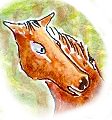
 |
The Hunt Ball - 6 |
The essential action is to reduce the temperature gradient. Insulating the backboard is a good idea. Using a water absorbent backboard without thermal insulation is dangerous. It is important to understand that humidity buffers only function when they are always at the same temperature as the object they are intended to protect, otherwise they actively de-stabilise the climate around the object.
Thermal insulation depends mostly on the thickness of the bubbly or fibrous material, and there is a limit to the æsthetically pleasing insulation thickness. One can also just establish a gap between backboard and wall, so the question is which is more effective: an air space where room air can flow past to warm the back of the picture or an equal thickness of insulating backboard? The choice depends on the thermal conductivity of the wall and the size of the picture, because the circulating air will cool according to the distance it must travel through the crevice between cold wall and backboard. If in doubt, an insulating backboard is a wise choice, unless you are in doubt about the wisdom of using backboards at all.
There is a "Backboard Project" with an international cast of experts whose aim is to define the ideal protection for the back of an oil painting. So far the project team has published an advanced mathematical analysis of the situation behind unglazed paintings subjected to a sudden change of RH in a constant temperature environment (1). I look forward to having to concentrate hard on their corresponding treatment of what happens in a fluctuating temperature gradient.
There are considerable practical difficulties in measuring what actually happens in detail. The temperature gradient can rather easily be measured continuously with a data logger and some very fine thermocouples embedded discreetly in a test picture. The moisture content is a much more difficult matter. The smallest easily available relative humidity sensor for measuring RH in an air space is about 5 x 3 x 1.5 mm. The thickness is rather large for testing the theory of uniform water content and varying RH, but it can maybe work if one deliberately makes a very wavy picture in a deep frame.
The moisture content of the paper is very difficult to measure accurately. A really high water content can be estimated by measuring the electrical resistance between two electrodes woven into the paper. Episodes of dew formation on the paper can be revealed, irreversibly, by dusting the paper with methylene blue dye before assembling the specimen, as mentioned earlier.
I am, at the time of writing, building an experimental device to measure the relative magnitude of the two opposing flows of moisture through porous materials in a temperature gradient. The process is of importance within outside walls as well as within picture frames hung against the wall.
I need scarcely remind paper conservators of the peculiarly relevant and curious story of the Dada artist Georges Renouilles, who invented a variant of Max Ernst's decalomania. He took plain sheets of paper and squeezed them into frames so that they buckled. He then exposed them on the outside of a wall so that moulds of various colours grew in the hollows, or the ridges, and dark wavy lines formed at the limit of evaporation from the bottom of the frame. He then dried these papers out and pressed them flat, sometimes returning them to the frames buckled in the other direction, so that he got some pictures that resembled Scots tartan. Andre Breton refused to let Georges into the surrealist club on the grounds that it was not truly automatic art but calculated scientific processing. Renouilles' art is hardly known now because, in his disappointment, he packed all his production away in a cellar in Paris' 19th arrondissement. When the boxes were opened after his death, the pictures were found to have suffered the ironic fate of rotting away uniformly in the moist cellar. As the ageing, but still sharp, Andre B remarked: this proved that it was scientific art because it was typical of a scientist not to apply to his personal life the lessons learned in his professional life.
Reference:
1. Giovanna Di Pietro and Frank Ligterink, 'Prediction of the relative humidity response of backboard protected canvas paintings' Studies in Conservation 44 (1999) 269-277.

This work is licensed under a Creative Commons Attribution-Noncommercial-No Derivative Works 3.0 License.